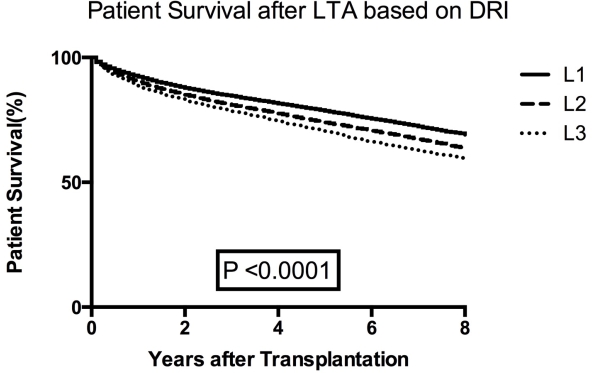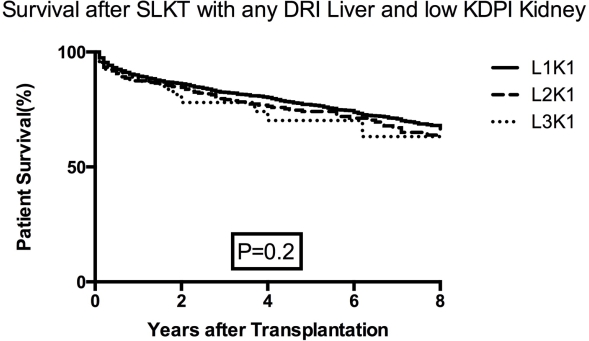The Importance of KDPI in Simultaneous Liver and Kidney Transplant.
1General Surgery, Rush University Medical Center, Chicago, IL
2Surgery, University of Washington, Seattle, WA.
Meeting: 2016 American Transplant Congress
Abstract number: B171
Keywords: Kidney/liver transplantation, Outcome, Renal function
Session Information
Session Name: Poster Session B: Kidney Issue in Liver Transplantation
Session Type: Poster Session
Date: Sunday, June 12, 2016
Session Time: 6:00pm-7:00pm
 Presentation Time: 6:00pm-7:00pm
Presentation Time: 6:00pm-7:00pm
Location: Halls C&D
Background: The use of the Donor Risk Index (DRI) in liver transplantation and the Kidney Donor Profile Index (KDPI) in kidney transplantation has been well studied. However, the combined effect of these indices on outcomes after simultaneous liver and kidney transplants (SLKT) has not been studied.
Methods: Our dataset included the UNOS/STAR database from 3/1/2002 to 3/31/2015 in patients who received a SLKT. DRI were calculated and the KDPI was taken from the STAR files in these patients. Livers were classified as low DRI (D1<1.3), moderate DRI (D2 = 1.3-1.7) or high DRI (>1.7). Kidneys were grouped into low KDPI (K1 ≤30%) or high KDPI (K2>30%). The survival outcomes were calculated of each pairing of DRI with KDPI (D1KI, D2K1, D3K1, D1K2, D2K2, D3K2)
Results: There were 4950 SLKT performed during this time period. Similar to liver transplants alone, a higher DRI predicts worse outcomes.  However, a low KDPI kidney mitigates the effect of DRI on survival and survival becomes equivalent in all three DRI groups.
However, a low KDPI kidney mitigates the effect of DRI on survival and survival becomes equivalent in all three DRI groups.  A high KDPI kidney worsens the effect of DRI and survival is markedly decreased.
A high KDPI kidney worsens the effect of DRI and survival is markedly decreased.
Conclusions: KDPI mitigates the effect of DRI on SLKT. Similar to liver transplant alone, renal function after SLKT appears to have a significant influence on survival.
CITATION INFORMATION: Chan E, Hertl M, Perkins J. The Importance of KDPI in Simultaneous Liver and Kidney Transplant. Am J Transplant. 2016;16 (suppl 3).
To cite this abstract in AMA style:
Chan E, Hertl M, Perkins J. The Importance of KDPI in Simultaneous Liver and Kidney Transplant. [abstract]. Am J Transplant. 2016; 16 (suppl 3). https://atcmeetingabstracts.com/abstract/the-importance-of-kdpi-in-simultaneous-liver-and-kidney-transplant/. Accessed December 13, 2025.« Back to 2016 American Transplant Congress
